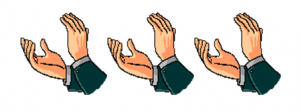APPLAUSE
June
I’ll hazard a guess that applause represents an evolutionary advance that took us humans beyond shrieking, stomping and pounding as a way of registering our approval. Somewhere along the way, clapping was reinforced by cheering and whistling, but it remains till today our principle form of expressing support and satisfaction. We need not elaborate on the varieties of applause other than to observe that men often go about it more aggressively and loudly, cupping their palms and forcefully driving them together whereas women try to be more decorous in their response, the sound emitted barely audible (some of us sometimes simply go through the motions of applauding intending not to produce sounds but simply to comply with what others nearby are doing).
Upon attaining young adulthood most of us have absorbed established applause protocol. For example, at an orchestral concert, the conductor as he approaches the podium is greeted by applause. Sustained clapping generally follows the conclusion of an opera aria. A pop singer announcing his next number elicits applause from an audience presumably pleased by his selection. A professional golfer having launched a thunderous drive will find the effort applauded by the gallery. A presidential State of the Union message always contains obvious applause lines though actual response levels depend upon partisan alignments. At the conclusion of a play applause builds as secondary players give way to the principal actors. (No doubt the slightest differences in applause levels register with those on stage.)
Applause is the way audiences communicate with performers, whether by withholding or repeatedly clapping. Tepid or “polite” applause usually signifies a notable absence of enthusiasm, whereas repeated and loud clapping or rhythmic applause is a distinctly favorable sign. With sustained applause at the end of certain performances, the audience may be delivering a message, signaling for an encore. Most performers, flattered by the response comply though some, even while continuing to bow, do not return after departing the stage.
Uncertainties about the process remain and awkward moments persist. Opinions still differ as to whether applause is appropriate after each movement of a symphony or concerto. Does one applaud in a house of worship? While audiences are often instructed to withhold applause until after a list of individuals is introduced, the effort to suppress clapping is often unsuccessful. Unsophisticated audience members often fail to applaud after each member of a jazz ensemble completes his solo section. People appear uncertain whether or not to applaud at the conclusion of a movie. Because people differ about such moments and others, situations arise occasionally when but a single individual begins clapping only to discover that he alone is applauding. What follows is: 1) others promptly join in, for applause often is contagious; 2) all alone, he immediately stops clapping, shrinks into his seat and pretends he had nothing to do with that unsupported “outburst’.
If you found something useful in or admirable about this presentation, it’s OK to ….
